The Atlanta Child Murders refers to a series of abductions and murders of African-American children and young adults that happened in Atlanta between 1979 and 1981 (though similar murders which were not added to the "official list" occurred in Atlanta before, during, and after). While a man named Wayne Williams is often identified as the perpetrator, he was only convicted of two of the murders and his conviction has been viewed with criticism in the years that followed.
The Atlanta Child Murders[]
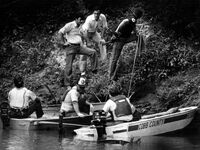
Investigators found the body of Nathaniel Cater, who was one of the two victims for whose murders Williams was convicted.
From 1979 to 1981, at least 30 African-American youths were found murdered in Atlanta, Georgia. Almost all of them were minors and most were fatally asphyxiated (sometimes the cause of death was listed as "probable asphyxia" or was undetermined). The first official victims were Edward Hope Smith, who was shot with a .22 gun, and Alfred Evans, whose cause of death was listed as "probable asphyxia", and was found in the same wooded area. Over the following years, victims kept turning up, though there were several other deaths and disappearances before, during and after the time of the listed murders that were not added to the list. During 1981, many victims were over 20 years old. They were still added to the authorities' "list" of suspected victims, though changes in the list's criteria for which deaths fit a pattern were not uncommon. At one point, a 16-year-old-boy, Patrick Rogers, was found dead in circumstances similar to the then-official pattern of the killings after being missing for almost a month, but he was not immediately added to the list when he was found in the Chattahoochee River, in the vicinity of where some other victims of the killings had been found, because he was a year too old. On May 24, the nude body of Nathaniel Cater, who had gone missing a few days earlier, was fished out of the Chattahoochee River. The cause of death was ruled as "probable asphyxia" caused by strangulation. This eventually led the authorities to the only man who, to date, has been convicted of any of the killings: Wayne Williams.
Wayne Williams[]
| “ | Modeling is more important than the talking we do. | ” |
— Williams
| ||
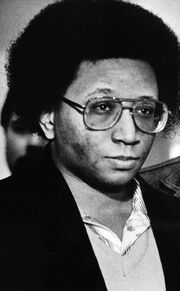
Wayne Bertram Williams was born in 1958 and raised in the Dixie Hills neighborhood of Atlanta (where also many of the Atlanta Child Murders' victims either lived or disappeared from), the only son of teachers Homer and Faye Williams. A brilliant student with above average I.Q., he graduated from Fredrick Douglas High School with an honors degree. Later, he studied business and finance at Georgia State University for a while, before dropping out to pursue a career as an entrepreneur. From a young age, Wayne had dreamed of making it in the entertainment and broadcasting industry. He was talented in mechanic and electronics, and, at sixteen, went as far as to establish, at his parents' expense, an amateur radio station, WRAZ, in his basement. Eventually, mainly because of Wayne's bad management, the station was closed after the Williams family and the Southwest Communications Systems, Inc. (the company with which WRAZ had merged in 1975) filed for bankruptcy. In his late teens, Williams worked part-time at area radio stations, hoping to gain some experience.
By 1976, Williams reinvented himself as a talent agent, claiming to have contacts in the Atlanta radio and music scenes (though most of those people claimed to have never met him). He was primarily interested in young boys, which he later claimed was because he was attempting to replicate the success of the Jackson Five. He kept spending his parents' money (to the point of bankrupting them) to create expensive demo recordings of children who, due to Wayne's poor ear for music, had mediocre abilities. At the time of his arrest, he was searching for talents for his group, called "Gemini", and had printed up hundreds of flyers that he distributed in arcades, skating rinks, shopping malls (places from where victims of the Atlanta murders reportedly disappeared). All the while, as a means to sustain himself, he worked as a freelance accident scene photographer, listening at night to the police scanner he had installed in his car, to get first on the scenes of arsons, murders, and other incidents.
As for his personality, Williams was known by his acquaintances and associates as something of a pathological liar and "bullshitter", always exaggerating details of his career, such as knowing important people or having the right contacts. He was also obsessed with police, and had reportedly learned how to impersonate a cop. In 1976, he went as far as to illegally equip his police-like sedan (which already had a scanner installed on), with red and blue lights, being consequently arrested for impersonating a police officer. He was also said to threaten to "arrest" children who hung out on the streets, whom he claimed were "drop shots", a slang term referring to a useless and worthless person who only deserves to be shot down. Williams never had an official girlfriend, being rumored by some to be homosexual and to sleep with male hookers. His sexuality was indeed ambiguous at best.
The Investigation of Williams[]
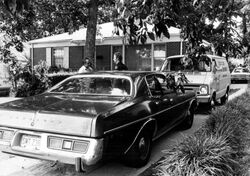
William's house and car.
Williams first came to the police's attention in the early hours of May 22, 1981, two days before the body of Nathaniel Cater was retrieved from the Chattahoochee River. Two police officers, Freddie Jacobs and Bob Campbell, were stationed near the James Jackson Parkway Bridge, which crossed the river, where some victims had been found, as well as the line between two counties. Just after Jacobs saw a car that he identified as a white 1970 Chevrolet station wagon cross the bridge, Campbell, who was beneath the bridge, heard a loud splash and saw the water ripple. Campbell then radioed an FBI agent, who pulled over the car, which was driven by Williams. He told the police he was on his way to a potential client named Cheryl Johnson, though she was nowhere to be found and the phone number and address at which Williams said she lived turned out to be fake. When Williams was asked about the incident in an interview for the Atlanta Monster podcast, he gave a number of inconsistent and contradictory stories to explain what happened; in one he said his mother had written down Johnson's address when she called their house, in another he said he himself had written down the address and misread his own handwriting, in some he said he was also going to a local club, the Sans Souci Lounge, and a record company, Hotlanta Records, on other errands as well in different orders. While Williams was questioned by the authorities, they searched the area near the bridge for bodies.
Though the medical examiner couldn't determine an exact time of death, he stated that Cater had been dead long enough to have been dropped from the bridge on the night in question; later, some witnesses claimed to have seen him alive in the days between May 21 and May 24, though their statements weren't made public. The investigators obtained search warrants for Williams' home, car and dog to get fiber samples to compare to fibers found on the victims and brought him in for questioning. When the police looked into his whereabouts for the afternoon of May 21, they couldn't confirm the story he gave them. They also put him through three polygraph tests, all of which he failed. Williams still maintained that he was innocent and even held a press conference outside his home. Over the following weeks, the FBI forensic labs matched fiber samples found on victims to samples from Williams' environment and witnesses who claimed to have seen Williams with various victims and who claimed to have seen cuts and scratches on his arms turned up. On June 21, Williams was arrested for the murders of Nathaniel Cater and Jimmy Payne, who had died in April.
Trial and Aftermath[]
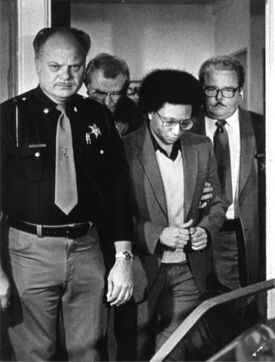
Williams (center right) being led to his trial.
Williams's trial began on December 28 and has been criticized for treating Williams and his defense unfairly by not giving them the time to prepare properly. The prosecution connected Cater's and Payne's deaths to ten of the other Atlanta child murders, none of which Williams was charged with and many of which didn't even fit the proposed pattern. The defense had little chance against the FBI investigators who were called to testify but brought in some experts of their own. Some of their testimonies ended in abject failure; the one who reexamined the times of death for Payne and Cater stated that Cater had been dead in the water for at least two weeks even though he hadn't even been missing that long. Williams also lost a great deal of credibility when a number of lies he had spun to people around him as well as his false alibi came out; among them were a friend of Williams who had been told that he flew fighter jets in the U.S. Air Force even though he hadn't done so and couldn't because he wore glasses. The prosecution also brought in witnesses who claimed to have seen Williams with some of the victims. They also stated that the fibers found on the victims and compared to the abundance of fiber evidence collected from Williams' environment showed that it was statistically impossible for anyone other than Williams to be the killer, though it was later remarked that most of the fibers in question weren't that rare and that the calculated probability that supposedly implicated Williams was based on incomplete records and assumptions. Additionally, no hairs or fibers from the victims were found in Williams' home or car, which is unlikely if he had transported them. The defense brought in more experts of their own. A hydrologist testified that it would have been impossible for Cater's body to turn up where it was found if it had been dropped from the bridge. Another stated that there was no indication that Cater or Payne had actually been murdered; Cater was a known alcohol and drug user and one of them had an enlarged heart who could easily have died of natural causes. They also brought in witnesses whose testimonies rebutted those made by the witnesses who implicated Williams; among them was a police sketch artist who testified that none of the many suspects she had been asked to sketch during the course of the investigations had looked like Williams. Unfortunately, the defense's case was damaged further when Williams himself was put on the stand and became hostile and angry during the questioning by the district attorney. In January of 1982, Williams was found guilty of killing Payne and Cater and received two life sentences. Not long afterward, the investigators announced that with him in prison, 24 of the 31 listed Atlanta child killings had been solved.
However, after the trial, events took place that threw Williams being identified as the perpetrator into question. Several key witnesses implicating Williams either turned out to be unreliable or admitted to having perjured themselves. One of them, Ruth Warren, a witness in the Lubie Geter case, had initially described a man she had seen with Geter as having a lightning-shaped scar on his cheek, but did not include this detail in her testimony in court; Williams has no such scar. When she later appeared on the ABC news program Nightline, she said she had never seen Williams before she saw him in court. Another witness, an ambulance driver identified as "Bobby Toland", who gave a testimony providing a motive for Williams, turned out to have had a personal grudge against Williams, to have been a self-described member of the Ku Klux Klan, to have said that he gave his statement for the reward money and to have testified under a false name, his actual name being Bobby Williams. It was also discovered that initial FBI reports describing the dog hairs found on the victims that were later used as evidence against Williams described them as grey or white with a tip and said that they were only indicative of an Alaskan Malamute or a Siberian Husky. However, reports written after Williams' arrest instead described the hairs as white or brown, similar to the Williams' family's German Shepherd. Also, the murder of Clifford Jones, one of the victims attributed to Williams, inspired further doubt when it turned out that another man, Jamie Brooks, had been a stronger suspect in the case and that the same supposedly rare fibers used to implicate Williams were also found on Jones.
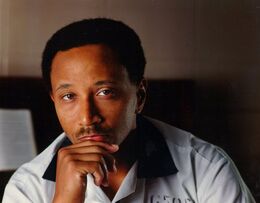
A more recent photo of Williams.
Still maintaining his innocence, Williams has spent the past decades fighting his conviction and trying to get a retrial while serving his sentence at Hancock State Prison. He has claimed that the investigators covered up evidence of KKK involvement in order to prevent a race war. The claim may have some credence since Charles T. Sanders, a white supremacist affiliated with the Klan, it was revealed in 2006, praised the killings in secretly recorded conversations. Sanders had also threatened to strangle one of the younger victims, Lubie Geter, because of a personal dispute; though Geter was indeed strangled, Sanders was not investigated as a suspect. Other theories include that there were multiple killers. In his book Mindhunter, which was published in 1995, profiler John Douglas stated that Williams probably committed eleven of the Atlanta child murders, but added that there was no strong evidence connecting him to most of the murders and disappearances. In 2007, attorneys for the State of Georgia allowed Williams' defense to reexamine dog hairs and human scalp hairs found on victim Patrick Baltazar (whose murder Williams was not actually convicted of) for DNA. The testing of the dog hairs was done by the University of California, Davis and wasn't too conclusive; since they only had mitochondrial DNA to work with, they couldn't be used to identify a single, unique dog as the source. The testing of the human hairs, on the other hand, was carried out by the FBI's lab in Quantico, Virginia and bore more fruit. They contained a very rare sequence of DNA that's only present in 29 of the 1148 African-American hair samples in the FBI database and not present in any of the Caucasian and Hispanic samples. Since Williams carries the sequence himself, he remains a suspect.
Other Suspects[]
- James Edward "Jamie" Brooks
- Laundromat manager
- Had prior convictions for rape and admitted to having sexually abused children
- A suspect in the murder of Clifford Jones in August of 1980.
- Was reportedly seen raping and killing Jones together with another man, Calvin Smith, by a witness and seen disposing of something large in the location where Jones' body was found by other witnesses, though the statements were apparently ignored by investigators and were not made public before Williams' trial
- Was arrested and convicted of aggravated assault and sodomy of a young boy in 1981 and later died in prison of AIDS
- Charles T. Sanders
- A suspect in the murder of Lubie Geter, found dead on February 5 of 1980
- Implicated along with his brothers, Jerry and Don Sanders
- KKK member and white supremacist; specifically a member of a more radical wing of the Klan known as the NSRP (National States' Rights Party)
- Drug dealer
- Confessed to the murder on a secret recording
- Sanders and his brothers were reportedly investigated for the murders for seven weeks, but were let go after passing polygraph tests. They were later arrested for various crimes related to their drug dealing and their activities in the KKK
- Tom Terrell
- Admitted to having engaged sexually with one of the official victims, Timothy Hill, who spent the night at Terrell's home the night before he was murdered
- Other official victims Patrick Baltazar and Jojo Bell were also known to have been at Terrell's home
- John David Wilcoxen
- Truck driver
- Known pedophile; had created child pornography and was a member of a local pedophile ring
- Was arrested for his involvement in a child pornography and child prostitution operation
- Listed victims Lubie Geter and Earl Terrell are known to have been in Wilcoxen's home months before they were murdered
Modus Operandi[]
Twenty-four of the thirty official victims of the Atlanta Child Murders, all young or adult males, were attributed to Wayne Williams, whose Modus Operandi apparently included: no forced abduction, either asphyxiation, strangulation, bludgeoning, stabbing, drowning (once) or neck-breaking (once), than dumping off the body in a secluded spot or into the Chattahoochee River.
For what concerns the other six official murders: in one case, that of Angel Lenair, the victim was a young girl who was strangled, and tied to a tree post-mortem. Lenair had a pair of underwear stuffed down her throat, and was also possibly sexually assaulted. In the remaining five cases, which involved four young males and another female victim (abducted from her home), the boy/girl was either killed by unknown causes or shot, which did not fitted the pattern of the other murders, or a pattern overall.
Profile[]
The offender (for at least eleven of the murders which fitted the pattern, and that were then attributed to Williams, though he was later attributed more) was profiled by John Douglas as being an adult black male, between the age of 25 and 29, who was, in all likelihood, unmarried and single. He possessed a dog, and was familiar with the spots where he dumped his victims. He was probably pampered and spoiled by his parents during his childhood, and began killing while experiencing a period of intense and unbearable stress. He may have been assaulted as a child, and had a history of small crimes or violent demeanor. He favored dark colors, and the ruse he exploited to fool his young victims may have been something related to the music industry.
The offender craved power, particularly power over others. This urge, when not satisfied legitimately, in the aspects of everyday life, drew him to murder. Although the murders seem to not have an explicit sexual connotation (as the victims who fit the pattern were not assaulted), the offender himself gained sexual excitement through the act of killing itself, which allowed him to exercise power and control over his victims. His obsessive search for power and authority over others may have oriented the offender also in the choice of his profession (or at least of his aspirations). He may have (or had) impersonated a police officer because of his compulsion, and would always carry a weapon with him, also driving an official looking vehicle. He probably demonstrated an uncommon interest in the medias, by the time the murders began.
Williams fitted many of these characteristics. He was attributed eleven of the Atlanta Child Murders by Douglas, though in most of the other cases, he said, there wasn't enough evidence to identify Williams as the perpetrator. Despite this, the latter was later attributed to a total of twenty-four murders.
Known Victims[]
Note: The dates in the following lists denote the date of the victim's disappearance.
- 1979:
- July 21: Edward Hope Smith, 14 (shot in the back with a .22; unresolved)
- July 25: Alfred Evans, 13 (apparently asphyxiated; attributed to Williams also by John Douglas, case closed)
- September 4: Milton Harvey, 14 (killed by unknown causes; unresolved)
- October 21: Joseph "Jojo" Bell, 9 (manually strangled; attributed to Williams, case closed)
- 1980:
- March 4: Angel Lenair, 12 (strangled with an electrical cord, tied to a tree, a pair of underwear were stuffed down her throat; possibly also sexually assaulted; unresolved)
- March 11: Jeffery Mathis, 10 (killed by unknown causes; his body was found on February 1981; unresolved)
- May 18: Eric Middlebrooks, 14 (bludgeoned; attributed to Williams also by John Douglas, case closed)
- June 9: Chris Richardson, 12 (bludgeoned; attributed to Williams, case closed)
- June 22: LaTonya Wilson, 7 (killed by unknown causes; unresolved)
- June 23: Aaron Wyche, 10 (his neck was snapped; attributed to Williams, case closed)
- July 6: Anthony Carter, 9 (stabbed repeatedly; attributed to Williams, case closed)
- July 30: Earl Terell, 11 (asphyxiated; attributed to Williams, case closed)
- August 20: Clifford Jones, 13 (strangled; attributed to Williams, case closed; possibly killed by Jamie Brooks)
- September 14: Darron Glass, 10 (killed by unknown causes; his body was never found; unresolved)
- October 9: Charles Stephens, 13 (asphyxiated; attributed to Williams also by John Douglas, case closed)
- November 1: Aaron Jackson, 9 (asphyxiated; attributed to Williams, case closed)
- November 10: Patrick Rogers, 16 (bludgeoned; attributed to Williams, case closed)
- 1981:
- January 3: Lubie Geter, 14 (strangled; attributed to Williams also by John Douglas, case closed; possibly killed by KKK member Charles T. Sanders)
- January 22: Terry Pue, 15 (strangled with an unspecified ligature; attributed to Williams, case closed; possibly killed by an unknown subject whose fingerprints were obtained from the corpse)
- February 6: Patrick Baltazar, 11 (strangled with an unspecified ligature; attributed to Williams also by John Douglas, case closed)
- February 19: Curtis Walker, 15 (strangled; attributed to Williams, case closed)
- March 2: Joseph Bell, 15 (asphyxiated; attributed to Williams also by John Douglas, case closed)
- March 13: Timothy Hill, 13 (drowned; attributed to Williams, case closed)
- March 20: Eddie Duncan, 21 (apparently asphyxiated; attributed to Williams, case closed)
- March 25: Michael McIntosh, 23 (apparently asphyxiated; attributed to Williams, case closed)
- May 11: William Barrett, 14 (strangled; attributed to Williams also by John Douglas, case closed)
- April 9: Larry Rogers, 20 (apparently strangled; attributed to Williams also by John Douglas, case closed)
- April 12: John Porter, 28 (stabbed six times; attributed to Williams also by John Douglas, case closed)
- April 21: Jimmy Ray Payne, 21 (apparently asphyxiated; Williams was convicted of the murder)
- May 22: Nathaniel Cater, 27 (apparently asphyxiated like the previous victim; Williams was convicted of the murder)
Notes[]
- Although Williams is popularly nicknamed "The Atlanta Child Killer", both of the victims whose murders he was convicted of were in their 20s (though most of the other cases were considered closed after Williams' conviction). Futhermore, only four of the thirty victims were actually children (under the age of ten) while the rest were pre-teens, teens, or young adults.
On Criminal Minds[]
- Season Two
- "Profiler, Profiled" - While not directly mentioned or referenced in this episode, the Atlanta Child Murders appears to have been an inspiration for the crimes committed by the episode's unsub, Carl Buford - Both were African-American serial killers who targeted African-American boys (though young men were also victims in the Atlanta killings), killed them via asphyxiation (though this was only one of the causes of death of the Atlanta victims), and had some sexual element in their crimes (Buford was a pedophile, while Williams was described as a lust murderer). Buford also appeared in Season Eight.
- "Fear and Loathing" - While not directly mentioned or referenced in this episode, Wayne Williams appears to have been an inspiration for the episode's unsub, Terrance Wakeland - Both were sexually motivated African-American serial killers who were around the same age when they committed their crimes, worked in music, targeted young African-Americans mainly of one gender (Wakeland targeted African-American teenage girls, while Williams mainly targeted African American boys and adults), and killed victims via various means (including beating, strangling, and stabbing).
- Novels
- Finishing School - Williams was mentioned when Rossi suggests that the unsub, who wrapped his victims in plastic to avoid leaving behind fiber evidence; Reid remarks that fact played a large part in convicting Williams.
- Season Eleven
- "Tribute" - While Williams or the Atlanta Child Murders weren't directly mentioned, a marker denoting to an infamous serial killer, seen on Reid's map of infamous serial killers by location, could be seen pointing to Atlanta's approximate location, possibly as a reference to either case.
Sources[]
- Wikipedia:
- The HBO documentary Atlanta's Missing and Murdered: The Lost Children
- The Atlanta Monster podcast
- TruTV Crime Library articles about Williams and the Atlanta Child Murders
- Radford University's summary of Williams' life
- 101 Crimes of the Century (2008)
- Atlanta's Missing and Murdered
- Carpenoctem's article about Williams
- CNN:
- UT San Diego article about the dog hair testing
- Our Georgia History's timeline of the Atlanta Child Murders
- The Crime Web's March timeline article that mentions the Atlanta Child Murders
- The World of Serial Killers blog article about Williams
- [http://www.tuscaloosanews.com/news/20010117/civil-rights-era-reporter-talks-about-his-concern-for-the-truth Tuscaloo News article from 2001}
- Atlanta child murders: Wayne Williams 'very like' FBI profile - MyAJC.com
- Article about the murders from MyAJC.com
- 1986 UPI article about witnesses in the case, including Ruth Warren and Bobby Toland
